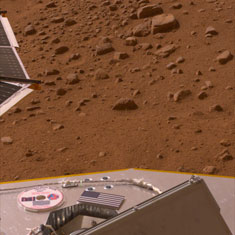
A view from the Phoenix Mars Lander on May 26, the day after it landed on the Red Planet. Photo: NASA/JPL-CalTech/University of Arizona
All Aboard for Mars
The Phoenix Lander touches down on the Red Planet with Tufts scientific equipment ready to search for signs of water-and life
By Marjorie Howard
The successful touchdown of the Phoenix Mars Lander on May 25 summoned a sense of mystery and wonder for a team of Tufts researchers involved in the project, which is seeking to discover if the Red Planet could support-or ever has supported-life.
Samuel Kounaves, a chemistry professor whose research team developed a wet chemistry lab that will test Martian soil and transmit data back to earth, awaited the landing at the Phoenix Science Operations Center in Tucson, Ariz., where he will remain to continue his portion of the project.
"I am humbled by the thought of being a part of something that used to be just science fiction," he says. "I am truly awed and inspired by the fact that we are 'working' on another world on a daily basis." Kounaves is now living on Mars time, a 24.6-hour day, as the research team maneuvers the Lander to begin its scientific tests. "I wish everyone on the earth could participate in some similar experience that expands the boundaries of human understanding," he says.
The Lander's robotic arm will dig through the ground surface, gathering soil for analysis on the craft. Kounaves and his students helped design what they call a "lab in a teacup," a tiny testing receptacle for the Martian soil. The four analytical cells each contain 26 sensors, which will measure the inorganic components of the soil, such as pH level and the levels of sodium and potassium.
After a scoop picks up the soil and dumps it into a receptacle, the soil will be reconstituted with water. Mars is cold and dry now, Kounaves says, but at one point, there was liquid water flowing on it. "So by reconstituting the Martian soil, it will tell us something about its ability to support life and if it will be toxic to future human astronauts."
Joining Kounaves in Tucson are research associate Suzanne Young, research technician Kalina Gospodinova and engineering graduate student Jason Kapit.
"Every moment while NASA was tracking the spacecraft was emotionally exhausting for all of us at the Science Operations Center," says Kapit. "As each maneuver passed by flawlessly, the excitement grew until the spacecraft finally came to a gentle touchdown on the surface. That moment was surreal."
The Phoenix Mars Lander was the first mission to land and transmit photographs from Mars' north pole. "The pictures were the first to show the pole of another planet and contained features that could very well indicate that water ice is close beneath the surface," says Kapit.
"That night, I looked up at the sky and saw Mars," adds Kapit. "I thought about how incredible it was that our spacecraft had traveled 423 million miles to that small reddish dot in the sky-that things we touched here on earth just nine months ago are now on that planet."
See earlier Tufts Journal stories about Sam Kounaves' Mars research:
Tufts-made Equipment will Test Martian Soil for Signs of Life
A Decade of Lab Work Hurtles Toward Mars
A Martian Adventure in Antarctica
Marjorie Howard may be reached at marjorie.howard@tufts.edu.


